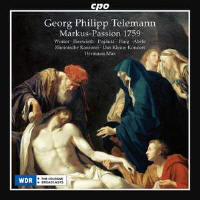Texte paru dans: / Appeared in: |
|
|
Outil de traduction ~ (Très approximatif) |
|
|
Reviewer: Bertil
van Boer
Georg Philipp
Telemann was obligated during his many years as the main city composer for
Hamburg to churn out a Passion each year, a requirement that was not unusual
in cities of the 18th century with substantial musical establishments. In
all, he turned out 46 of them, or, divided by four, about 12 each according
to the four Gospels. Not all have survived; indeed, only about half did so,
and even these were subject to alteration, revision, and reuse by later
composers, who probably likewise occasionally chafed under this requirement.
His own grandson Michael cut and pasted a number of them, some at the behest
of the composer and others as his grandfather’s successor for a few years
until Emanuel Bach was hired. When Michael moved on to Jelgava (or Mittau as
it was then known) in Latvia, he took with him a number of these pieces,
performing them for many years, and sometimes even sending some off to other
colleagues elsewhere. That is how the 1759 Passion According to St. Mark
surfaced in Brussels, misattributed to Johann Heinrich Rolle. Thus, a set of
fragmentary parts and the pared down version in Belgium can be united to
reconstruct this one work.
There is no
evidence that Telemann simply dashed these works off, and in this case he
seems to have had a particular interest in its formulation, intending it to
be a model for the future of the genre (never mind that the genre itself was
on the way out in favor of more dramatic Passion Oratorios, such as Karl
Heinrich Graun’s Der Tod Jesu, which had appeared a couple of years prior).
The only real change here is that, as the booklets note, the testo or
narrator is set for alto. The orchestration follows the seasonal norms, with
softer woodwinds for the main arias and eschewing brass instruments. There
is no introduction, and a plethora of accompanied chorales that need no
particular discussion. Where the beauty of the work lies is in the
accompanied recitatives and solo numbers, where the non-Biblical text is
supplanted by allegorical commentary. A couple of examples will give an idea
of this. After the first narrative and accompanying chorales, the character of Contemplation (Die Betrachtung) has a rather descriptive (and perhaps a tad grisly) recitative before the short aria entitled by the composer “Cavata.” The first has a proud invocation, with decisive strings, and following a short recitative, the arioso enters on the words depicting the “fear of death.” A final recitative flourish and the aria “Rührt uns des frommen Bruders Schmerz” is a more gentle pastoral, flowingly depicting the somnambulant attitude is a pastoral compound meter, only to be followed quickly by a chorale with a minuet tempo. A bit later, “Wie spielend fährt auf glatten Wellen” has the waves outlined by the oboes, but as the tenor reaches the “rise and foam” the passagework increases in both the voice and instruments, with peaks, runs, and flourishes. Here, we are far from the Baroque Passion and more along the line of the emerging Empfindsamkeit. This is even more evident in the short B section, where the “tempestuous fate” rolls about with tumbling melody.
In the second
section, the aria of Imitation (Die Nachahmung, “Wenn dir mit hönischen
Gesicht”) trips rather arrogantly about with staccato violins portraying the
hypocrite’s scorn, while Courage (Der Mut, “Verrät’rische Frage”) begins
with a swirl of strings rushing up and down scales, while the bass voice
soon rolls about in imitation, depicting the fleeing of the High Priest and
his subterfuge for Christ’s blood in a flurry of sequences. Finally, the
duet between Jesus and a sinner (“Wie blutig bist du”) is surprisingly
gentle, with thoughtful suspensions between the soprano and bass before
splitting into a brief dialogue. The string accompaniment is soft and
pensive. The ending of this Passion is a series of “chain arias” (one after
the other), sort of like a prelude to the final chorus. Here God leads off
with a fluid lyrical benediction, after which a pair of angels sing in
parallel thirds an ethereal short hymn of praise. Religion then admonishes
mankind with meandering melody to ponder the conclusion with “It is
finished.” The final chorus, the longest of the Passion, alternates between
major and minor mode, indicating the mixed reactions to the sacrifice. It is
moving, and quite effective, even if the work ends with the usual chorale. The soloists are all quite adept at this style of 18th century Affekt, having recorded this repertory often before. Both soprano Veronika Winter and alto Anne Bierwirth have clear and bright voices that blend well together, while tenor Georg Poplutz once again demonstrates his familiarity with excellent renditions of the tenor part. Markus Flaig’s resonant baritone fills the roster, along with bass Ekkehard Abele, both of whom have the necessary flexibility to make this Passion work. As always, the Rheinische Kantorei is clear and precise in their diction and ability to blend together, and one cannot find fault with the smooth precision of Das Kleine Konzert. Conductor Hermann Max, no stranger to this repertory, instinctively knows how to bring out the many advanced stylistic features and subtleties of Telemann’s score. This is not, repeat not, the often complex harmony of the Baroque, but rather a Passion of lightness, which in turn presents a clear and present message. If one wants a wonderful work, nicely performed, this is one set you should get.
| |
|
|
|
|
Cliquez l'un ou l'autre
bouton pour découvrir bien d'autres critiques de CD |
|




